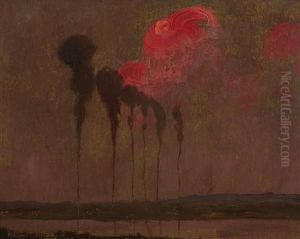Edward Maccartan Paintings
Edward Francis McCartan was an American sculptor known for his works that often fused Art Nouveau sensibilities with classical elements. Born on August 16, 1879, in Albany, New York, he grew up in a time when America was experiencing significant social and artistic changes. McCartan received his early education at the Christian Brothers Academy and the Albany Academy. He showed an early interest in art and was particularly drawn to sculpture.
In 1903, McCartan moved to New York City to further his education in the arts. He enrolled at the Art Students League, where he studied under Hermon Atkins MacNeil, and later continued his studies at the National Academy of Design. Demonstrating considerable talent, he was awarded the Rome Prize in 1907, which allowed him to study at the American Academy in Rome until 1910. This experience deeply influenced his artistic style, as he absorbed the classical traditions of sculpture.
Upon returning to the United States, McCartan established himself in New York and began to create works that reflected his unique blend of contemporary and classical styles. His sculptures often depicted mythological or allegorical figures, and he became well known for his elegant, flowing forms and his ability to capture movement in bronze.
During the 1920s and '30s, McCartan's reputation grew, and he received numerous commissions for decorative and public works. Some of his notable sculptures include 'Diana' (1922), 'Nymph and Fawn' (1923), and 'Echo' (1926). He also created a number of war memorials, which were widely praised for their emotional impact and artistic merit.
In addition to his own practice, McCartan was an influential educator. He taught at the Art Students League and served as the Director of the Beaux-Arts Institute of Design in New York. Through teaching, he influenced a new generation of sculptors and contributed to the development of American sculpture.
Edward McCartan's work is part of the collections of many major museums, including the Metropolitan Museum of Art and the Smithsonian American Art Museum. His role in bridging the gap between traditional and modern sculpture, as well as his influence as an educator, continues to be recognized in the history of American art.
McCartan's career was unfortunately cut short by his untimely death on September 20, 1946. Despite his relatively brief career, his legacy lives on in his sculptures, which remain an integral part of America's artistic heritage.
